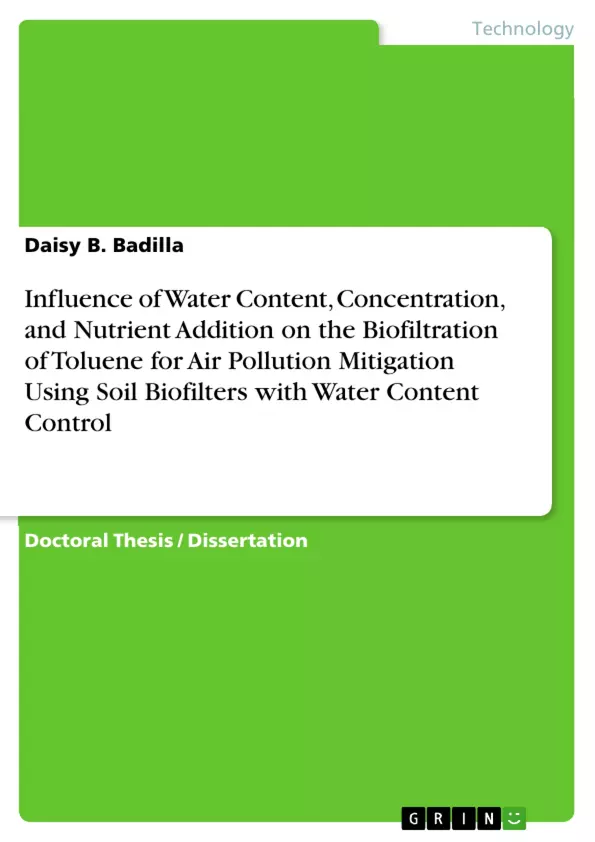In this study, the influence of water content on biofiltration performance was investigated. A biofilter reactor with water content control through changes in matric potential in a suction cell was used to treat toluene-contaminated air with soil as the filter bed medium. Results suggest the soil water content should be controlled at about 96% (dry weight) or a matric potential of -10 cm H2O. The maximum elimination capacity in this study appears to be a restricted to a narrow water content and this narrow range impacts on the operation of full-scale biofilters as traditional techniques for water content control would make maintaining this range difficult.
Biofiltration, which is also sometimes referred to as bio-oxidation, is a method of air pollution control where contaminants in a gas stream are metabolized by microorganisms and converted to water, carbon dioxide and biomass. Biofiltration involves biological, chemical, and physical processes. It is often preferred over other air pollution control technologies since it does not produce secondary pollutants and does not involve expensive maintenance and operating costs. However, one of its disadvantages is the difficulty in controlling water content.
A water retention curve of the soil was generated by plotting water content versus matric potential with data obtained using the suction cell. Two additional factors, concentration and nutrient addition, were investigated using two other soil biofilters. Improved biofiltration performance was observed at higher toluene concentrations. High toluene concentrations may be advisable during start-up as it converts microorganisms that do not thrive on toluene into nutrients for desired degraders inducing growth and improved performance but would have to be controlled to avoid excessive growth. In the membrane biofilter, the large pores in the biofilm contributed to a possible enhancement of pollutant and oxygen mass transfer.
Nutrient addition improved the volumetric removal rate of toluene which implies that available nutrient has been limited. Nitrogen was identified as limiting the biomass growth. The production of carbon dioxide confirmed effective biodegradation of toluene in the soil biofilter.
This study contributes to existing knowledge relevant conclusions and recommendations that may guide biofiltration operation, broaden concepts, or direct future studies and it considers treatment of indoor air pollution as a particular area of application.
Inhaltsverzeichnis (Table of Contents)
- Chapter 1
- Introduction
- Background
- Air Pollution and Volatile Organic Compounds
- Biofiltration as an Air Pollution Control Technology
Zielsetzung und Themenschwerpunkte (Objectives and Key Themes)
This dissertation investigates the influence of various factors on the biofiltration of toluene, a volatile organic compound (VOC) commonly found in air pollution. The research focuses on optimizing the biofiltration process using soil biofilters with water content control.
- Impact of water content on toluene biofiltration efficiency
- Influence of toluene concentration on biofilter performance
- Effects of nutrient addition on microbial activity and biodegradation rates
- Development and application of a biofiltration system with controlled water content
- Evaluation of the long-term stability and effectiveness of the biofiltration system
Zusammenfassung der Kapitel (Chapter Summaries)
Chapter 1 provides an introduction to the problem of air pollution, highlighting the significance of volatile organic compounds (VOCs) as a major contributor. It explores the advantages of biofiltration as an air pollution control technology, outlining the process and mechanism of biodegradation within biofilters.
Schlüsselwörter (Keywords)
The research focuses on air pollution mitigation, toluene biofiltration, soil biofilters, water content control, nutrient addition, microbial activity, VOC degradation, and sustainable environmental technologies. These keywords represent the core concepts and research areas explored within the dissertation.
- Quote paper
- Daisy B. Badilla (Author), 2011, Influence of Water Content, Concentration, and Nutrient Addition on the Biofiltration of Toluene for Air Pollution Mitigation Using Soil Biofilters with Water Content Control, Munich, GRIN Verlag, https://www.grin.com/document/1442932



